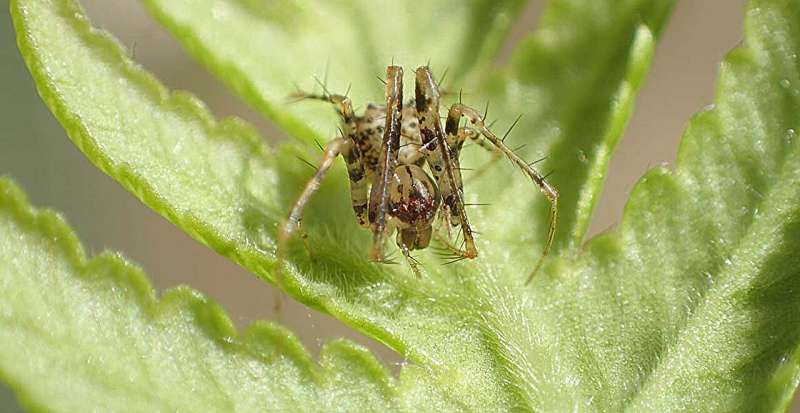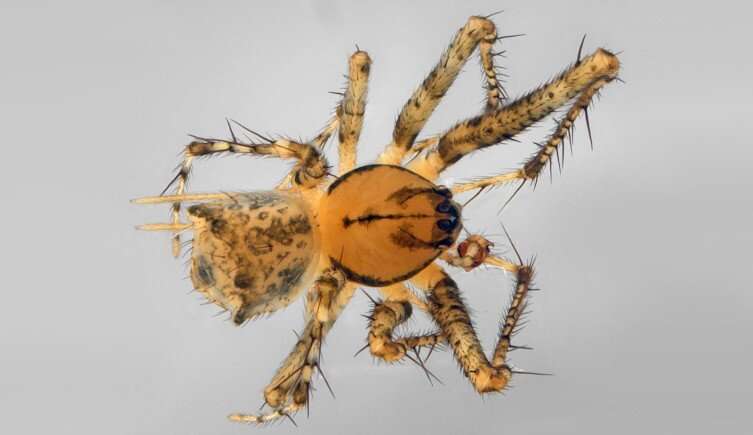This article has been reviewed according to Science X's editorial process and policies. Editors have highlighted the following attributes while ensuring the content's credibility:
fact-checked
trusted source
proofread
New species of pirate spiders discovered on South Atlantic island

On a remote tropical island in the Atlantic Ocean, a pair of marooned pirates have been discovered. While they lack eyepatches and cutlasses, the two new species of pirate spider certainly live up to their nautical name, which refers to their habit of violently taking over the webs of other spiders and killing the occupants.
Having been confused for a closely related species, the two new spiders have been hiding out on St Helena for decades. Now newly recognized, it's hoped the spiders will provide added impetus to preserve the island's threatened cloud forest.
Danni Sherwood, the lead author of a new study of these spiders, says, "Our work showed that two species new to science existed in the cloud forest, but for over four decades they were thought to be a single, common, species which can be found in many parts of the world including the U.K."
"These spiders don't just have interesting morphology. Their type localities are in one of the most unique and threatened habitats in the world: the Saint Helenian cloud forest. Knowing what species are there and which are found nowhere else helps with efforts to conserve the cloud forest as a whole."
The findings were published in the European Journal of Taxonomy.
Island of invertebrates
Found 2,000 kilometers off the coast of west Africa, St Helena is one of the most isolated places on Earth. With environments ranging from tropical forests to desert-like coasts, it has developed a biodiversity unlike anywhere else.
The cloud forest found around the island's peaks are particularly important. The trees capture water from the clouds, which then drains to the lower parts of the island and accounts for about 60% of the water falling on St Helena every year.
This supports a variety of unique plants, such as the he cabbage-tree and black scale fern, which in turn play host to at least 120 invertebrate species found nowhere else in the world.
Unfortunately, very little of this original forest now remains. The historic clearance of the forest for cattle and crops, as well as the introduction of invasive species, has left only small, fragmented patches remaining.
The U.K. government, supported by the Saint Helena National Trust, RSPB and Species Recovery Trust are working to reverse these declines through the St Helena Cloud Forest Project. But this means it is now more important than ever to work out what exactly is living in the cloud forest.
One species thought to have made the forest its home was Ero aphana, a pirate spider normally found in western Europe. It was thought it had been inadvertently introduced during the last 500 years, but when the research team went back to examine specimens of the spider, they realized something was amiss.
Dr. Ben Price, who is the Natural History Museum's Senior Curator in Charge of Small Orders, was a co-author of the research.
"We were carrying out a project to improve the DNA reference library for St Helena, so that the people of the island can monitor their biodiversity more easily," Ben explains. "This has been using a mix of museum specimens and freshly collected ones to help fill gaps in our knowledge."
"Danni already suspected that Ero aphana might not be all that it appears, so we added it into the mix. It turns out that there's not just one pirate spider on the island, but two entirely different species."

How were the new pirate spiders discovered?
A close examination of the spiders provided the first hints that they were different species. Ero lizae has two spike-like structures at the back of its body, while Ero natashae is significantly smaller. DNA evidence also played a role in proving these spiders were their own species.
"There are a lot of cryptic species for which DNA is one of the few, if only, ways of distinguishing between them," Ben says. "While DNA in typical museum specimens tends to fragment rapidly in the first decade or so after collection, it slows down significantly after that."
"This means that sequencing the DNA of a 150-year-old specimen isn't that different from sequencing a 50-year-old one, so we were able to use methods developed for ancient DNA to extract genetic material from two legs of Ero lizae. Its genetics are significantly different from Ero aphana, showing they couldn't be the same species."
Based on this information, the researchers were confident enough to formally describe two new species from specimens kept in the Natural History Museum, London, and the Royal Museum of Central Africa in Belgium.
The species were named in honor of Liza Fowler and Natasha Stevens, two conservationists working at the St Helena National Trust.
"Naming these species after two friends and colleagues who did so much to help me during my visit to Saint Helena in 2022, and who have spent years dedicated to saving Saint Helenian invertebrates, was a great pleasure," Danni says.
While little is currently known about these spiders, it's hoped that further research will help to work out how they live, and how they can be allowed to thrive.
More information: Danniella Sherwood et al, Two new sympatric species of the pirate spider genus Ero C.L. Koch, 1836 from the cloud forest of Saint Helena Island, South Atlantic Ocean (Araneae: Mimetidae), European Journal of Taxonomy (2024). DOI: 10.5852/ejt.2024.921.2417
Provided by Natural History Museum
This story is republished courtesy of Natural History Museum. Read the original story here.




















